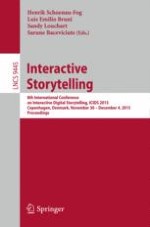2015 | Book
Interactive Storytelling
8th International Conference on Interactive Digital Storytelling, ICIDS 2015, Copenhagen, Denmark, November 30 - December 4, 2015, Proceedings
Editors: Henrik Schoenau-Fog, Luis Emilio Bruni, Sandy Louchart, Sarune Baceviciute
Publisher: Springer International Publishing
Book Series : Lecture Notes in Computer Science
